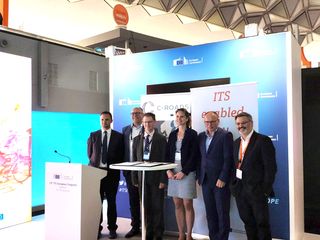With the collaboration of DATEX II and the C-Roads Platform, two major European initiatives for harmonisation join forces against the background of emerging cooperative intelligent transport services (C-ITS). Both of them have used various opportunities to demonstrate their technical and strategic importance in increasing the safety and efficiency of transport in Europe and beyond. With high potential for synergies, a cooperation between DATEX II and C-Roads was the logical next step. The ITS Europe Congress 2019 in Eindhoven provides the backdrop for the signature of a collaboration agreement.
When it comes to improving safety and efficiency of road transport, C-ITS services are definitely to be regarded a key enabling technology. Several stakeholders from the policy and industry sector have empowered the ventures made so far with C-ITS services. The European Commission, together with Member State representatives, municipalities, OEMs and technology providers have aligned their efforts and found a preliminary peak in the C-Roads Platform. C-Roads unites 16, and soon 18, European States with coordinated national pilots and cross-site testing activities to achieve transnational interoperability. In this way, C-Roads will ensure European cohesion of C-ITS deployment and is currently preparing a sustainable rollout of services.
From there, the way leads further upwards as an alliance with another powerful European standardisation initiative is just about to be sealed: DATEX II. As a standardised e-language for traffic and travel data exchange, DATEX II plays an important role in the world of established and mature ITS services and has been operating successfully for many years. Acknowledging this, the European Commission refers to DATEX II as a preferred standard in several Delegated Acts supplementing the ITS Directive 2010/40/EU. 18 Member states participate actively in the DATEX II organisation, which is hosted by CEDR. To support the European dimension of the work, the EC has awarded a five-year grant to the Action entitled “DATEX II Programme Support Action (PSA) for Intelligent Transport Services (ITS) for Road”. Complementary to the further development of DATEX II, the PSA aims provide adequate support to the DATEX II user community.
C-ITS enables vehicles to interact directly with each other and the surrounding road infrastructure. In road transport, C-ITS typically involves vehicle-to-vehicle (V2V) and vehicle-to-infrastructure (V2I) communication. There is broad consensus on technical and organisational level that C-ITS services need to be linked with the existing service landscape for maximising their impact. Road operators usually hold essential information for V2I communication from traffic control centres (TCCs). As this kind of exchange is often done using DATEX II, the standard takes a high-potential role in the data chain to provide C-ITS services.
For this reason, it is sensible to adapt the DATEX II model with regard to the developments of C-ITS services. Requirements should be harmonised and aligned in both C-ITS and DATEX II messages in order to guarantee an efficient exchange of information. The different requirements need to be considered for the future standardisation process of data exchange between road operators and C-ITS stations.
The C-Roads Platform and the DATEX II PSA both acknowledge the key role of platforms and organisations. For effective collaboration, they have agreed on linking their efforts for their mutual advantage and the benefit of their stakeholders.

Contact - DATEX II PSA
Marjolein Masclee
Chairperson
Phone: + 31 6 52 35 46 46
E-mail: marjolein.masclee(at)rws.nl
Web: http://www.datex2.eu
Contact - C-Roads Platform
Martin Böhm
General Secretary
Phone: +43 1 26 33 444-63
E-mail: Martin.Boehm(at)austriatech.at
Web: http://www.c-roads.eu
Twitter: @cRoadsPlatform